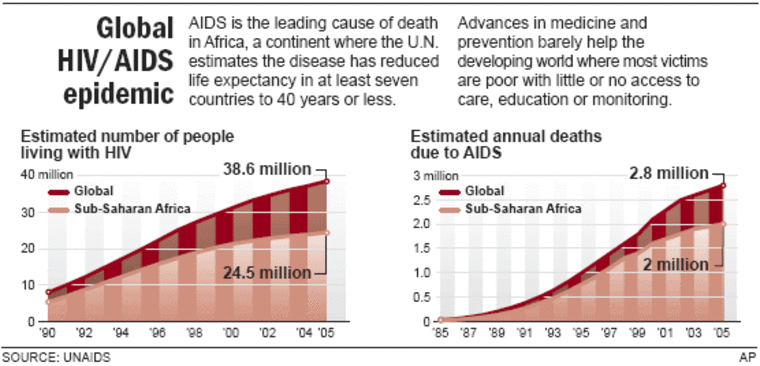It is a chronicle of abysmal failure punctuated with occasional astounding acts of bravery and dedication.
No one could have known in 1981 when the CDC first detailed the cases of the “5 young men, all active homosexuals,” with a rare pneumonia (two of whom had died) that the report heralded a plague with 25 million dead and an estimated 65 million infected worldwide so far.
When doctors at UCLA first connected those five cases — diagnosed from October 1980 to May 1981 — and contacted the CDC, the seeds for a massive worldwide crisis were well in place. But the numbers of infections and deaths could have been far fewer.
In my own reporting, an entire year passed from that first CDC report until I did the first story on evening network news. By then, the condition, still not called AIDS, had afflicted just over 400 Americans and killed 100.
Why did we delay so long?
Other things seemed more important on the science and medicine beat: the attempts to implant an artificial heart; the follow up to the eruption of Mt. St. Helens the year before; and dozens of other stories that seem trivial in hindsight.
Keeping it quiet
The reluctance of the gay community to scream for help also played a big role in the lack of coverage. Gay men were just winning freedom from repression and many saw the disease as an attempt by society to return to the days when homosexuals could be arrested for simply being in a public place together. Many wanted to keep the whole thing quiet even as they watched their friends die. The famous activist Larry Kramer eloquently described this time in his 1985 play “The Normal Heart.”
That June 5, 1981 report said the infections were likely caused by “some aspect of a homosexual lifestyle or disease acquired through sexual contact.”
At the beginning, there was the suspicion that some drug might be responsible. Inhalants known as ‘poppers’ used for stimulants were at the center of one common hypothesis.
But a year of intense work by CDC medical detectives left no doubt. In June, 1982 they concluded that the world faced “a new, deadly sexually transmitted disease.” A month later it got the name: AIDS.
From then on a few medical reporters picked up the story on a regular basis.
But there was little governmental response. President Ronald Reagan famously refused to say the word “AIDS” for six-and-a-half years.
In contrast, President George W. Bush’s recent speech on the threat of pandemic influenza shows how effective leadership can focus the nation’s attention and resources on a health danger.
Pattern of denial
Meanwhile, in much of the gay community, the denial continued, with few efforts to encourage safe sex. What a tragedy!
Samples of blood taken from gay men show that most of those who got infected in this country acquired the virus in 1983 and 1984. Lack of action squandered the opportunity to save hundreds of thousands of lives in the U.S. alone
The pattern of denial and lack of political leadership spread throughout the world along with the virus. Fear and blame accounted for much of the response.
In her 1989 book “AIDS and its Metaphors,” Susan Sontag wrote “Plagues are invariably regarded as judgments on society, and the metaphoric inflation of AIDS into such a judgment also accustoms people to the inevitability of global spread. This is a traditional use of sexually transmitted diseases: to be described as punishments not just of individuals but of groups.”
In those early years we did stories of people losing their jobs and homes because they had the disease. A nurse in the Bronx told me how X-ray technicians had run from the room when she brought in a beautiful three-year-old boy with AIDS.
Among those suffering the worst persecution were Haitians living in New York, many of them illegal immigrants who spoke little English. When the CDC learned of the first cases among Haitians they found they were neither drug users nor homosexuals. So the government declared being a Haitian itself to be a risk group.
In a visit to Port-au-Prince in 1983, we found graphic evidence that the virus almost certainly spread from the U.S. to Haiti and not the other way around. But many want to blame a plague on someone else — especially if that someone else is poor and dark-skinned.
As word spread that the origin of AIDS was in Africa, the focus of the blame shifted there. African leaders were so reluctant to acknowledge the problem that my crew and I were threatened with arrest several times when we tried to report the story in several African countries. We only got the first report from Tanzania because the telephone lines went down and we were able to sneak into the village of Bukoba.
The stigma accounted partly for the refusal of many African leaders to acknowledge the problem — this time leading to millions of deaths.
As I said, there have been heroes who stood up to this bigotry. They have included doctors, scientists, pharmaceutical executives, and a few politicians.
But, mostly, it was the activists who refused to die quietly.
They demanded effective treatments just as they scream today for those treatments to be available throughout the world.
On this 25th anniversary, we must remember there is still no cure and we have gone from a disease that had struck five people to a plague that kills more than five every minute of every day.
